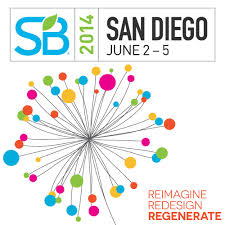The Big Pivot
A Conversation with Andrew Winston at Sustainable Brands 2014

At the Sustainable Brands San Diego Conference 2014, sustainability and marketing executives from top companies around the world gathered to discuss what their companies are doing to promote greater environmental sustainability while building the value of their brands. The depth of the sustainability programs represented varied from the deep green, like Patagonia and Buycott, to 3M, which had Forest Ethics protesting its use of the infamous SFI certification for its post-it notes from boats on the bay just outside the conference center. Yet, whether the changes the companies had made so far were big or small, the conversations at the conference did prove that corporate America is at the beginning of a great shift towards redefining their brands and the way that customers derive value from their products with health and sustainability in mind. Some companies were just further along than others.
Front and center of this discussion was School of Forestry and  Environmental Studies alumnus Andrew Winston, who defines this shift as, The Big Pivot, the title of his latest book, which every conference attendee received a copy of. The book describes the challenges that businesses will face given an increasingly resource constrained world due to climate change and population growth. It then provides ten strategies for leaders to use to change the way their companies operate to succeed in this fundamentally changed world. The strategies advocate brilliant things like taking a longer-term view, changing the incentives to engage the whole organization, redefining ROI, inspiring customers to care and use less, and being extremely innovative and collaborative to deeply challenge conventional wisdom. Winston explained these strategies in one of the first plenaries of the conference and they were echoed in speeches and conversations all week long.
Environmental Studies alumnus Andrew Winston, who defines this shift as, The Big Pivot, the title of his latest book, which every conference attendee received a copy of. The book describes the challenges that businesses will face given an increasingly resource constrained world due to climate change and population growth. It then provides ten strategies for leaders to use to change the way their companies operate to succeed in this fundamentally changed world. The strategies advocate brilliant things like taking a longer-term view, changing the incentives to engage the whole organization, redefining ROI, inspiring customers to care and use less, and being extremely innovative and collaborative to deeply challenge conventional wisdom. Winston explained these strategies in one of the first plenaries of the conference and they were echoed in speeches and conversations all week long.
I got to sit down with Winston between two sessions to ask him about some of the challenges leaders and companies would face in actually implementing these changes and achieving that paradoxical goal of economic growth while reducing environmental impact that everyone at the conference was after. I am going to focus on two in particular here: the need to innovate away the tradeoffs that are commonly associated with environmentally preferable products so we don’t even need to talk to customers about “sustainability,” while at the same time needing to inspire consumers to care about using less.
 These were both big themes of the conference. In the book, Winston calls for “heretical innovation” such that we create things that are simply better and inherently more sustainable. Recent popular innovations like Uber and Lyft got a great deal of attention for advancing the “sharing” or “collaborative” economy and making it such that people have access to car services, without actually needing to produce any additional cars. They cause us to question our assumptions about needing to own a car. As a result, it can be argued that they are simply better at providing the services that people need, while reducing resource use on new cars.
These were both big themes of the conference. In the book, Winston calls for “heretical innovation” such that we create things that are simply better and inherently more sustainable. Recent popular innovations like Uber and Lyft got a great deal of attention for advancing the “sharing” or “collaborative” economy and making it such that people have access to car services, without actually needing to produce any additional cars. They cause us to question our assumptions about needing to own a car. As a result, it can be argued that they are simply better at providing the services that people need, while reducing resource use on new cars.
Though he didn’t reference these companies specifically in the book, I asked Winston if he thought these kinds of companies were really creating a more sustainable lifestyle. He said, “Car sharing programs seem to reduce the number of cars on the road, but we don’t have the numbers on their impact yet. They could change the way we consume…but it’s hard to imagine sharing everything.”
Yet, Winston also talks about inspiring consumers to care about the environment and to use less. He cites the Toyota Prius inspiring customers to go hybrid and use less gas, and Patagonia’s famous “Don’t Buy This Jacket!” campaign as examples of when companies have done this successfully. When I asked whether companies should be focusing on inspiring customers to care, or innovating such that no trade-offs are necessary, Winston explained that it all depends on the industry and where the biggest resource drains are in that industry. For example, “The water we use to shampoo our hair, and the energy we use to heat the water, dwarfs the resources needed to make the product…which is why if Unilever wants to talk about cutting water, it needs to talk about using water,” says Winston. On the other hand, “Levis is totally different because the lion’s share of the water use in jeans’ lifecycle has traditionally been in making the denim and the dying process.” This is why the denim industry needs radical innovation to improve its processes, (though Levi’s does also talk to its customers about limiting washes of jeans and using cold water). “Meat eating is a big industry where I can’t see a world where we all eat the same amount of meat that we eat today,” he adds.
Despite all of this debate over when companies can innovate their way to greater sustainability and inherently better products, and when they need to inspire customers to care about using less, my favorite passage in the book is the below: “Does it matter if consumers ‘care’?...do we need to wait for customers and consumers to care? Companies create needs all the time—to be brutally honest with ourselves, it’s a core competency of good consumer products companies…When something is basically a commodity, like most consumer products, then differentiation comes from good marketing or the creation of needs. So when companies say they can’t sell greener products because customers don’t want them, it’s a copout,” (p. 237).
We can’t wait for customers to care. It does not matter if they care on their own. Brands need to make them care, and they have the power to do that. If good marketing can make customers care about the varying lengths of the bristles in their toothbrush, it can make customers care about stopping climate change.
A “sustainable brand” needs to mean a brand that is both making customers care and going ahead and investing in innovation that will drastically improve the sustainability of the services it offers anyway. One of the best things about Sustainable Brands 2014 is that it brought many of the people with power over the decisions needed to make “The Big Pivot” a reality for the top global brands together in one beautiful place to inspire, and hopefully challenge, each other to step up to the challenge.
Header photo from gfpeck/flickr
